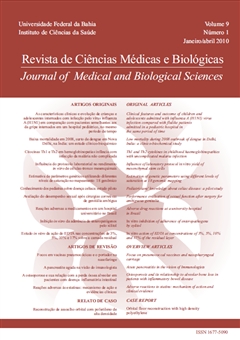Orbital floor reconstruction with high density polyethylene
DOI:
https://doi.org/10.9771/cmbio.v9i1.4646Keywords:
Orbital fractures – Surgery – High density polyethyleneAbstract
Surgical interventions in blow out fractures are generally indicated in cases of alterations in orbital function (e.g. diplopia)and for aesthetic reasons (e.g. enophthalmos). In assessing the severity of the injury, the clinician often uses parameterssuch as changes in visual acuity, patient-reported diplopia, changes in globe position and evaluation of the extraocularmuscles in association with imaging exams. Computed tomography has been the modality of choice for detailed imagingdiagnosis and surgical planning of orbital trauma. High density polyethylene may be successfully used in orbital floorreconstruction to restore function and esthetics. Taking into account the follow up of six months, the availability and theadvantages of high density polyethylene implants, it can be concluded that their use in reconstruction of orbital floordefects is a good choice.Downloads
Download data is not yet available.
Downloads
Published
2010-01-01
How to Cite
Pozza, D. H., Blaya, D. S., Oliveira, M. A. M. de, Neto, N. R., & Oliveira, M. G. de. (2010). Orbital floor reconstruction with high density polyethylene. Journal of Medical and Biological Sciences, 9(1), 87–90. https://doi.org/10.9771/cmbio.v9i1.4646
Issue
Section
Relato de Caso
License
The Journal of Medical and Biological Sciences reserves all copyrights of published works, including translations, allowing, however, their subsequent reproduction as transcription, with proper citation of source, through the Creative Commons license. The periodical has free and free access.


